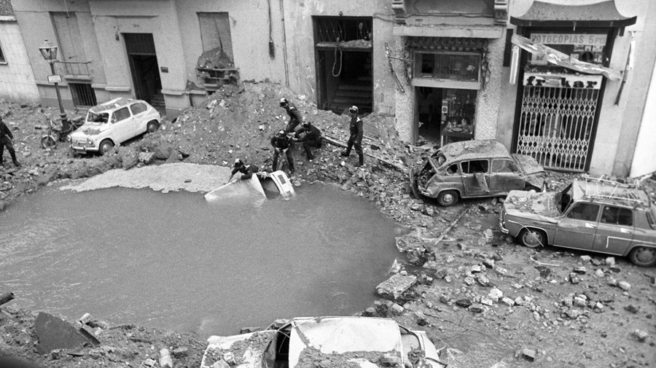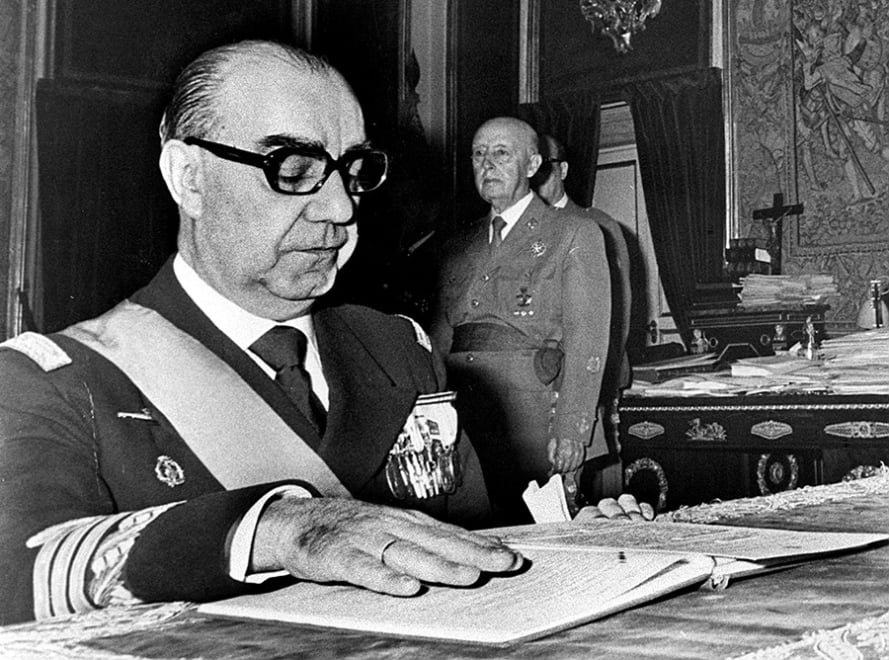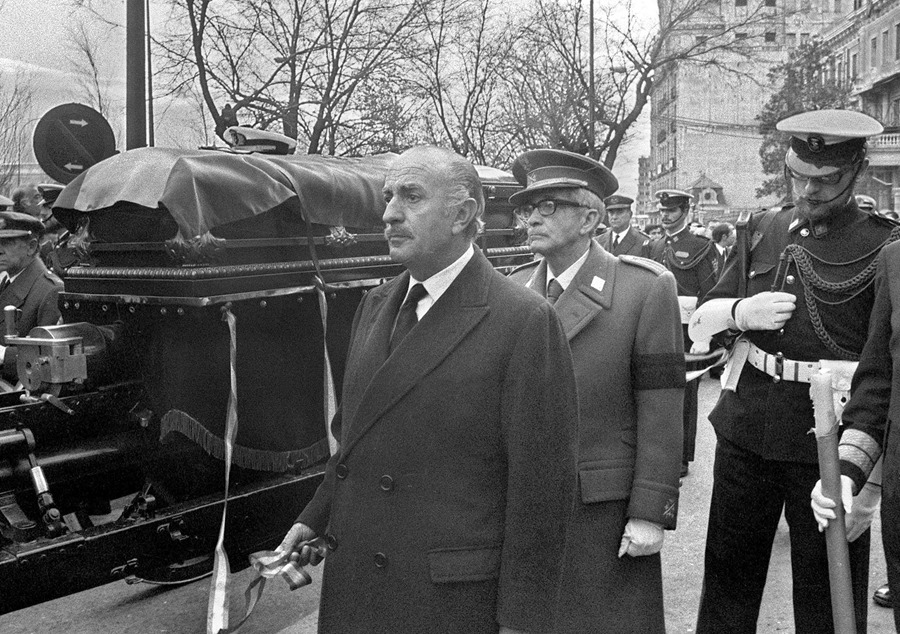

Site of the explosion that killed Carrero Blanco.
At first his intention was to kidnap him and demand him in exchange for the release of 150 ETA members behind bars, but when he became Francisco Franco’s right-hand man, his bodyguards complicated things and decided to kill him. Luis Carrero Blanco (Santonia 1904 – Madrid 1973) had just become president of the government when they began excavations. They rented a room on Claudio Coelho Street, which the lieutenant passed by every day on his way home from mass. They placed dynamite right under the asphalt and on December 20, 1973, exactly 50 years ago, they pressed a button and everything exploded. He was in office for six months.
This was the biggest attack on Francoism since its founding. Also the rise of ETA as a terrorist organization for some and an anti-fascist symbol for others, for all as a participant in the future transition, during which blood was shed throughout the country.
The explosion occurred at 9:28. The Prime Minister returned to his home for breakfast on Hermanos Becker Street after the traditional morning mass in the church. San Francisco de Borja, when in the house of Claudio Coelho at number 104, an explosion caused the car in which he was traveling, a Dodge Dart, to fly through the air, along with his driver, José Luis Perez, and Juan Antonio Bueno, his escort. 50 kilograms of dynamite buried under the asphalt formed a huge crater 20 meters wide and more than three meters deep. The car flew more than 30 meters and landed on the roof of a nearby building that belonged to the Jesuits. Carrero Blanco died in what is now the Gregorio Marañon Hospital, and the two policemen did not survive even a few minutes.

Standing on a ladder leaning against the building being excavated from were two suspected electricians. These were ETA members José Miguel Beñarán, known as Argala, and Jesús Sugarramurdi, nicknamed Kiskur. It was from there that they pressed the explosion button and went out to get into the car with Javier Larreategui, Achulo, which they stopped on Lagasca Street and in which they fled to their hideout in Alcorcón. These were the Chikiya Commandos and they successfully carried out what they called Operation Ogre and it changed the course of the country.
At first, due to the strong smell emanating from the hole in the ground, it was thought that it was a gas leak, but that same night, ETA, through Radio Paris, claimed responsibility for the attack, saying that it was a “just revolutionary response” of the working class and of our entire Basque people to the death of nine of our ETA comrades.”
“The death of Carrero is the beginning of the Transition. Nobody wanted to adequately clarify the attack because it was of interest to everyone.”
Manuel Cerdan
The next day, a huge funeral procession filled the Paseo de la Castellana. Juan Carlos de Borbón walked behind the body of Carrero Blanco. And also Cardinal Tarancon, whom the harshest Francoists called “red” because they considered him a representative of the soft branch of the regime and more open than the rest. He was buried in El Pardo Cemetery and many say he was forgotten too quickly.
Soon after, thanks to the cooperation of Eva Forest, a dissident of the Communist Party, three ETA members fled to the south of France. They had an easier time than expected, both with the preparation of the attack, and with its execution and the consequences that the assassination of the president would have on any person. It was easier, because no one expected it: there were no terrorist attacks or serious threats in Madrid, so Carrero’s white car was not armored.
Moreover, while the six-meter tunnel was being excavated, neither the police, nor the civil guard, nor the intelligence services saw anything suspicious. Then came the 1977 amnesty, and the ETA members were never jailed, their case was opened as if it were not the death of the president. As investigative journalist Manuel Cerdan explained in an interview with this newspaper: “For me, Carrero’s death is the beginning of the Transition. No one wanted to adequately clarify the attack because everyone was interested in it. Someone allowed it to happen, and someone covered up what they allowed. “No one investigated, not even Carrero Blanco’s employees in his secret service, SECED, not to mention his successor Arias Navarro. And then, with the amnesty, everything was forgotten.”

But the consequences soon became noticeable. Carrero Blanco was a strong man of a dictator who was already very old and in decline. Many considered him too soft for the moment, while others saw him as the spitting image of Franco. This attack, although it seems unthinkable today, even received approval from some anti-Franco circles. And also the most difficult sectors of the Franco regime. Moreover, for some, ETA became a branch of the anti-Franco struggle, and the success of the death of the government president led to the armed wing gaining the upper hand over those who sought a peaceful solution in politics.
“Carrero supported Prince Juan Carlos, but there was a fundamentalist wing in El Pardo that did not give up the idea of marrying Alfonso de Borbon to Franco’s granddaughter.”
MANUEL CERDAN
“Carrero’s attack benefits everyone, but I believe that those who stood behind it wanted to carry out a coup d’état and bring to power someone from the most rancid wing of Francoism. The dictatorship was not the stone block of all-encompassing power that is often described: “There were many disagreements and family wars, even on the issue of succession to the throne. Carrero supported Prince Juan Carlos, but there was a fundamentalist wing in El Pardo that did not give up the idea of marrying Alfonso de Borbon to Franco’s granddaughter.” Cerdan added that he does not deny ETA’s authorship, but suspects that some greater force helped carry out this “perfect murder.”
He goes on to clear up some of the rumors that have surrounded the murder for years. “They bring explosives from the Basque Country, spend weeks building a tunnel 100 meters from the American embassy, which has an anti-vibration system that detects any movement, and finish it at the same time as the Secretary of State arrives in Madrid. “This is something truly unthinkable,” he commented, but assured , that this does not mean that the US was behind it, but only that “they allowed it to be done because it was good for it.”
“Carrero’s death cleared the way. We don’t know if he would have been alive, if he had been alive, everything would have been as easy, in quotes, or as fast, or if there would have been any problems. Doubts remain,” he says about how he considers his death to be the beginning of the Transition. .
Source: El Independiente